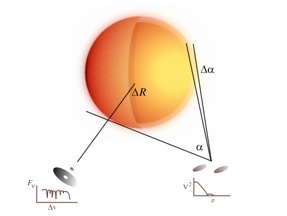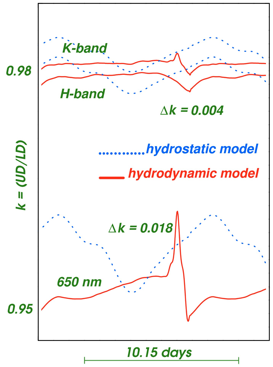
Cepheid stars are the yardstick to measure cosmological distances. A relation between their luminosity and the period of their regular pulsation makes it possible to use Cepheids as “standard candles” to derive the distance of the galaxies in which they can be observed. This relation, however, requires to be calibrated by using a handful of nearby Cepheids of which the distance can be determined with some independent method. With the advent of optical and infrared interferometers, the Baade-Wesselink method allows to derive the distance of a Cepheid by purely geometric means: by measuring the radial velocity of the stellar pulsation from spectroscopic lines and the variation of its angular radius with an interferometer, the distance of the star and its physical radius can be derived:

This technique, however, requires a sophisticated knowledge of the Cepheid atmosphere, and in particular of the “p-factor” and the “limb darkening” of the pulsating star. The p-factor allows to convert the radial velocities measured spectroscopically into pulsational velocities, which are integrated to derive the stellar radius Rm and its variations in time. The limb darkening is instead a measure of the variation of surface brightness projected across the disk of the star, and in Cepheids it is modulated with time as the star pulsate.

To enable high precision measurement of interferometric Baade-Wesselink distances, we have developed a procedure to compute realistic limb darkening for Classical Cepheids, using time-dependent hydrodynamic calculations of the Cepheid pulsations [1,2,3]. Our method improves on limb darkening derived with hydrostatic models, because it takes into account the time-dependent structure of the Cepheid atmosphere, as the star pulsates. The resulting limb darkening is physically consistent, and ultimately allows to derive a more reliable value of the Cepheid distance.
Cepheids Mass Loss
Given their role as primary distance indicators, having a good understanding of Cepheids evolution is of paramount importance. Current evolutionary models, however, predict a stellar mass for Classical Cepheids which is not consistent with their dynamical mass. Among the different hypothesis invoked to solve the mystery, there is the possibility that Cepheid stars may have lost some of their mass in their previous evolutionary stages, or that the Cepheid phase itself may be characterized by mass loss.
Stars lose their mass primarily by way of stellar winds. If Cepheids do lose their mass, then the ejected material should be visible in the Cepheid circumstellar environment, in the form of a shell of gas or dust. Preliminary indications that this may be the case were obtained with the infrared satellite IRAS (McAlary &Welch, 1986) and by the detection of circumstellar shells with ground based interferometers (Merand et al. 2006, 2007, Kervella et al. 2006). Such circumstellar material, however, has never been directly imaged.
By using the Spitzer Space Telescope InfraRed Array Camera (IRAC) and the Multiband Imaging Photometer (MIPS) we have detected an infrared excess around a sample of 7 nearby Cepheids [4]. This excess is the first direct evidence that Cepheid stars have warm (500K) circumstellar dust, that may be associated to stellar mass loss. For some of these Cepheids, including the class prototype δ Cephei, we have imaged extended emission at 8, 24 and 70 μm. This emission, that reaches a distance as high as 10,000 AU from the star, may be the key to understand Cepheids mass loss, and finally solve the mystery of the Cepheids mass discrepancy.

Extended emission around δ Cephei, observed by Spitzer IRAC and MIPS (Marengo et al. in preparation)

For more information:
[1] Theoretical Limb Darkening for Pulsating Cepheids, Marengo, M., Sasselov, D.D., Karovska, M., Papaliolios, C., Armstrong, J.T. 2002, ApJ 567, 1131
[2] Theoretical Limb Darkening for Classical Cepheids: II. Corrections for the Geometric Baade-Wesselink Method, Marengo, M., Karovska, M., Sasselov, D.D., Armstrong, J.T., Nordgren, T.E. 2003, ApJ 589, 968
[3] An Error Analysis of the Geometric Baade-Wesselink Method, Marengo, M, Karovska, M., Sasselov, D., Sanchez, M. 2004 ApJ 603, 285
[4] Spitzer Observations of Classical Cepheids, Evans, N.R., Barmby, P, Marengo, M., Bono, G., Welch, D., Romaniello, M. 2007, American Astronomical Society Meeting 210, #13.05
